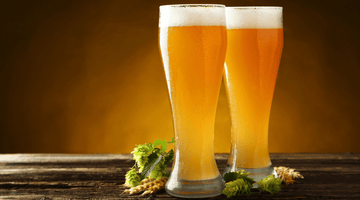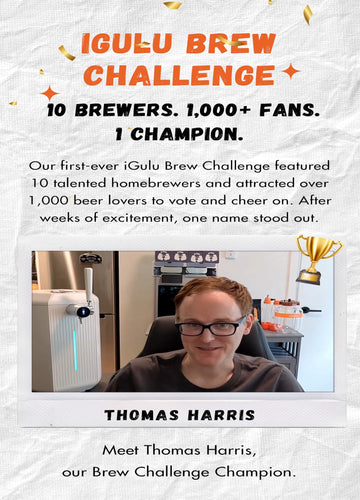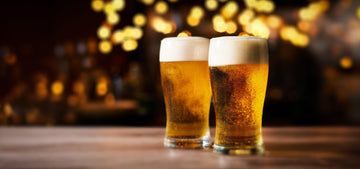We challenged master brewer Brian Benham from Benham Brewing to create a dry-hopped New England IPA using the iGulu F1. A crucial aspect of brewing with the iGulu was finding a way to replicate the ability to brew not only New England IPAs, but to develop a technique that could be applied to virtually all beer styles when brewing in this system. To achieve this, we found it essential to boil hops according to a hop schedule in wort, not just water. Adding some sugar to the boil can also help enhance the bitter flavors that are so important in beer. By following these steps, we were able to create a delicious dry-hopped New England IPA using the iGulu, despite its different characteristics from a standard craft brew setup.
Many iGulu users have reported on forums that they are doing a full wort boil, with a gallon and a half of liquid, boiling it down to a gallon, chilling it, and then transferring it to the iGulu. This method undoubtedly results in excellent flavor extraction and complete control over fermentation, producing fantastic beers. However, the drawback is that it significantly increases brew day duration, as it requires an hour of boiling and additional cooling time.
To address this issue, Brian aimed to develop a method to extract maximum flavor from hops without having to boil the entire wort. The solution was to perform a concentrated boil with malt and water, adding hops to extract full flavor. This method allows for minimum cool-down time and makes it easy to pitch the hop tea into the iGulu toward the end of fermentation.
Ingredients
FERMENTABLES
1 lb Light DME
8 oz Wheat DME
1.21oz DME
HOPS
.2 oz Citra (12%) 60 Min
.07oz Mosaic (13%) 30 Min
.1oz Nugget (13%) 10 Min
.1oz Nugget (Dry Hop)
.08oz Citra (Dry Hop)
.08oz Mosaic (Dry Hop)
YEAST
Yeast- Voss Kveik
Instructions:
Day 1
1. Pour 1 Gallon of water into your keg and add about 1/3 of a pack of Voss Kveik yeast to the top of the water.
Brian has opted to use Voss Kveik yeast for two reasons:
- Voss Kveik has fast fermentation properties
- It tends to produce or enhance an orange and citrus flavor in the beer, which is desirable for our New England IPA.
By allowing the yeast to contribute to the fermentation process, we can expect it to help enhance the hop flavor and reduce any harsh bitterness.
3. Add 1 lb of DME (light-dried extract is acceptable) and 1/2 pound of wheat-dried malt extract to the keg.
4. Lock and seal your keg, and place it inside the F1 Beer Brewer. Make sure to attach the pressure relief device valve, which keeps the pressure release valve open, as we will not require any pressure during the first fermentation stage.
5. The iGulu should be set to no pressure and 90°F for three days. This will result in a fast fermentation.
At this stage, no hops have been added, they will be added later once primary fermentation is almost complete. The main reason for not wanting to do pressure fermentation for primary fermentation is the issues it causes when dry hopping the beer. In testing, due to not boiling the full extent of the wort, there is a tendency for excessive foaming and head retention when pouring the beer from the iGulu.
When a beer is under pressure and the lid is popped off, dry hopping will cause a volcano of beer and all the solution will come out. This is not desirable for primary fermentation as pressure fermentation is not necessary at this stage. Therefore, it is best to allow the pressure to dissipate
Day 2
On the second day of fermentation, while the iGulu is bubbling away and doing its job, it is time to prepare the hop tea that Brian recommends for adding bitterness to the beer.
1. Six cups of water should be taken in a saucepan and placed on the stove.
2. Then, 1.2 ounces of dried malt extract should be added and dissolved nicely. The mixture should be brought to a boil.
3. Once it comes to a boil, the following hop schedule and corresponding amounts should be followed:
Once all the hops have been added and the mixture has boiled for the recommended hour, it should be allowed to cool down a little bit to a temperature of 180-190 degrees Fahrenheit.
4. Pour it into a heat-safe jar, such as a Mason jar. Cover the jar with foil and let it cool overnight.
Note: Don't add it to the iGulu yet. The hop addition, which starts tomorrow, requires preparation!
Day 3
Today, we will add hop bitterness. The hop tea will be used for the main bitterness, and the beer will also be dry-hopped.
1. Remove the keg from the F1. Take off the lid and remove the pressure relief valve accessory that keeps the valve open. The secondary fermentation, needs to be done under pressure.
2. Pour the hot tea from the Mason jar into the keg, leaving as many hop solids behind in the jar as possible.
Secondary fermentation under pressure is important for two reasons. The malt sugar that Brian has added enhances the hop bitterness flavor and improves the interactions in the hop oils. It also helps to carbonate the beer during this second stage.
3. Once the hop tea has been poured in, add the dry hops.
(Brian is using 0.1 oz of nugget, 0.8 oz of Citra, and the same amount of Mosaic.)
Optional: Brian has modified the Tritan keg to include, a floating dip tube with a screen. This means that anything thrown in there will be filtered out in the final beer, and there is no need to worry about anything clogging the beer lines.
4. Hops should be secured in a mesh bag, a stainless steel strainer, or something similar to keep them from clogging the beer lines.
5. Once all the hops have been added, the keg should be returned to the iGulu.
By allowing the yeast to consume the sugars, the hop flavor is enhanced and its integration into the beer is promoted. The beer should be crash-cooled to the desired serving temperature and left to rest for an additional three days, allowing the hop flavor to continue developing.
The aroma is vibrant with citrus notes, particularly orange peel. The hops are present in the aroma but not overpowering in the beer. The bitterness is crisp without being overwhelming, avoiding both excessive softness and the palate-numbing intensity of imperial IPAs.
Watch the full video tutorial by Benham Brewing below and let us know how your brew went on our forums:







